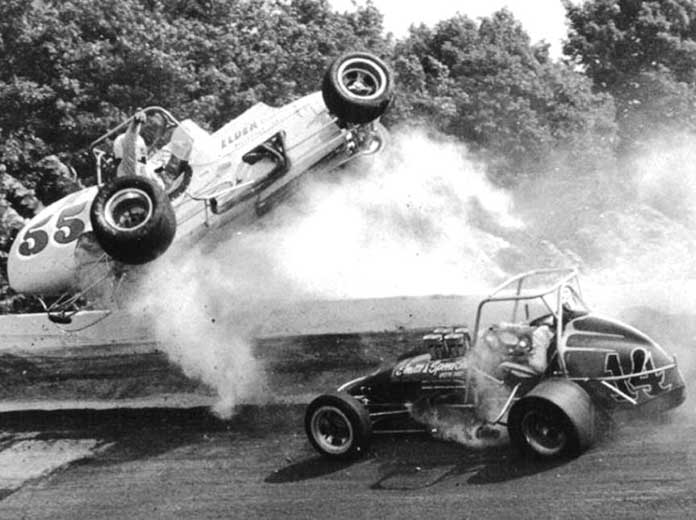
“I was with Duane that day,” recalled Johnny Parsons, then seven years old. “I remember how calm he was even though two guys had died, and he had to qualify. He sent a crew member down to the first turn with a broom to clean up some gravel. Then he climbed in and set a new world record. He and my mom had recently married, so we still had that stepfather thing going on. But I gained a lot of respect for him that day.”
Parsons’ “Black Sunday” experience may have added to his fear when he encountered the high banks early in his career.
“I first started racing on Winchester and Salem in 1968,” he recalled. “And I’ll tell you how intimidating they were. Whenever I traveled to a track, I never noticed passing a cemetery, except when I was going to Salem or Winchester.”
Intimidated or not, in 1972 Parsons set track records at Winchester for sprint cars and midgets.
“The trick at both tracks,” explained Parsons, “was to learn from the guys that were good there — Sammy Sessions, Sony Ates, Charlie Masters. Charlie never became a big star, but he knew how to get around those places.”
Lee Kunzman’s first experience with the banked tracks came at Winchester for an IMCA race. He got help from Masters, although it took a bit of deciphering to understand it.
“I was scared to death my first time at Winchester,” Kunzman acknowledged. “I found out later the car was trash. It jumped all over the track. I went to Charlie Masters — he was good on those banked tracks — and I asked him what I needed.
“He said, ‘Giterup onda haeil!’
Puzzled, Kunzman asked again with the same result. “Giterup onda haeil!”
“I didn’t know what the hell he was saying,” laughed Kunzman.
Kunzman wasn’t prepared for the hefty dose of Hoosier twang and Southern Indiana slang. Translated Charlie told him to, “Get ’er up on the hill.”
“I tried it some, but a spindle broke and I went right to the wall. I wasn’t sure I wanted to go back,” Kunzman said. “But, I did. And the more I got up on the hill, the faster I got until I was going pretty good.”
Success on the banks also required smoothness from a driver. Don’t drive in deep and stand on the brakes. Pick up the throttle quickly, but gingerly. “That’s why Winchester and Salem were so good at preparing you for Indy,” insisted Parsons.
In addition to the daring challenge, getting to Indy was yet another attraction to these unique speedways. 1955 Indianapolis 500 winner Bob Sweikert said, “Without tracks like Salem, most of us would’ve never gotten to Indianapolis.”
Sweikert died at Salem in 1956.
Pat O’Connor was another who made it to Indianapolis because of high bank prowess. As did Eddie Sachs, Mike Nazaruk, and later A.J. Foyt and Parnelli Jones, whose high-bank battles were epic.
Despite his disdain for the banks, Jones still borrowed Foyt’s sprint car to run Salem in 1964. That was after Jones had won Indy and begun to back down from oval-track racing. While Foyt raced in Europe, Jones went to his shop, hauled his car to Salem and won the feature. Foyt still insists, “He stole the damn thing.”
After Gordon Johncock, Bobby Unser, Johnny Rutherford and Mario Andretti made their way to Indianapolis through the “Idiot Circuit,” the tracks’ status as a step to Indianapolis diminished.
That didn’t prevent another generation of drivers from producing their own inimitable racing.
Gary Bettenhausen and Larry Dickson carried their “Thunder and Lightning” show to the banks. Pancho Carter mastered them, taking four consecutive Joe James/Pat O’Connor sprint car memorials at Salem.
Rich Vogler and Jeff Gordon thrilled ESPN audiences with their battles in sprint cars and midgets. Rich Vogler won a record 13 features at Salem, including the 1990 race he died in.
Tony Stewart, Stevie Reeves, Ryan Newman and Robbie Stanley, who died at Winchester in 1994, represent another generation of high-bank masters.
As USAC backed away from paved tracks, ARCA picked up the racing action there. Today, future NASCAR stars follow the likes of Darrell Waltrip, Jimmie Johnson, and Rusty Wallace who honed their skills at Winchester and Salem.
Meanwhile, USAC transitioned the Joe James/Pat O’Connor Memorial into a Silver Crown race as opposed to sprint cars. In 2019, Kody Swanson won his fourth consecutive Memorial, matching Pancho Carter’s record.
The breath-holding racing that made Winchester and Salem nationally recognized motorsports landmarks continues.
